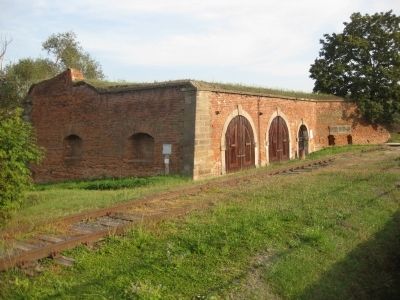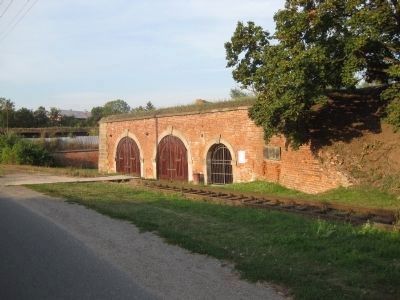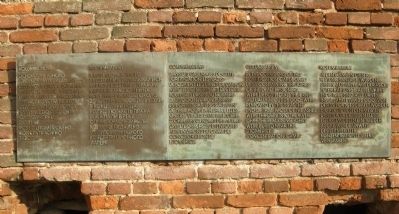Terezín in Litoměřice, Aussiger, Czech Republic — Northwestern Bohemia (Central Europe)
Columbarium
In Czech:
Kolumbárium
Do choheb tohoto opevnění byly ukládaný lepenkové urny s popelem mrtvých vĕzňů. Všechny urny – bylo jich na 25 tisíc – esesáci koncem roku 1944 odvezli vĕtšinu popela vysypali do Řeky Ohře, část zakopali do zemĕ poblíž Litomĕřického Koncentračního Tábora.
In Russian:
Koлумбарий
В kоридорах зтого укрепления укладываись картонные урны с прахом мервых заключенных. Все урны- их было около 25 тысяч – зсзсовцы увезли в конце1944 года. Большую часть праха высыпали в реку огрже, а часть зарыли в землю недалеко от литомержицкого концентрационного галеря.
In French:
Columbarium
Dans les casemates de cette fortification, les Nazis deposaient les urnes de carton avec les cendres des décedés. Toutes les urnes, au nombre de 25,000 environ, furent emportées par les SS ŕ la fin de 1944. Pour la plupart elles ont été vidées dans la Rivičre d’Ohře. Les cendres des autres ont été dispersées et enfouies aux environs du camp de concentration de Litoměřice.
In English:
Columbarium
In the corridors of this fortification cardboard urns containing the ashes of the dead prisoners were deposited. All the urns – actually about 25,000 – were removed by the SS by the end of 1944. Most of the ashes were thrown into the River Ohře, the remaining ashes were buried near the Litoměřice Concentration Camp.
In German:
Kolumbarium
In den Gängen diesen Festungsanlage wurden Urnen aus Pappe mit der Asche toter Häftlinge aufbewahrt. Ende 1944 sind all Urnen – ingesamt etwa 25,000 – von der SS fortgeschafft worden. Die Aschen von den meisten

Photographed By Andrew Ruppenstein, August 25, 2009
2. Columbarium - From the North
According to the United States Holocaust Memorial Museum:"...living conditions in the ghetto with respect to food supply, medicine, maintenance of residential structures, provision of basic services, and overpopulation in a limited space caused a death rate in the camp-ghetto comparable to that in Reich concentration camps like Dachau and Buchenwald. In 1942, the death rate within the ghetto accelerated so dramatically that the Germans built -- to the south of the ghetto -- a crematorium capable of handling almost 200 bodies a day.... Of the approximately 140,000 Jews transferred to Theresienstadt, nearly 90,000 were deported to points further east and almost certain death. Roughly 33,000 died in Theresienstadt itself."
Topics and series. This historical marker is listed in these topic lists: Cemeteries & Burial Sites • Notable Buildings • War, World II. In addition, it is included in the The Holocaust series list. A significant historical year for this entry is 1944.
Location. 50° 30.367′ N, 14° 8.982′ E. Marker is in Terezín, Ústecký kraj (Aussiger), in Litoměřice. Marker is on Bohušovická brána south of Horní vodní brána, on the left when traveling south. The columbarium is located, essentially, in the casemates on the south side of the town, halfway between the edge of town and the cemetery. Touch for map. Marker is in this post office area: Terezín, Ústecký kraj 411 55, Czech Republic. Touch for directions.
Other nearby markers. At least 2 other markers are within walking distance of this marker. The Food Storeroom (approx. 0.3 kilometers away); Garrison Church (approx. half a kilometer away).
More about this marker. The marker is mounted on the front wall of the columbarium, located to the right of the barred archway.
Regarding Columbarium. Terezín (Theresienstadt) became best known for its historical role in WW II when under German occupation, the entire town was turned into a concentration camp, with the Small Fortress turned into a Gestapo prison, and the Large Fortress turned into a ghetto into which Jews, mostly from Czechoslovakia, were forcibly relocated.
Also see . . .

Photographed By Andrew Ruppenstein, August 25, 2009
3. Columbarium - From the South
According to Hans Günther Adler, Theresienstadt 1941 - 1945, Das Antlitz einer Zwangsgemeinschaft . as cited in www.ghetto-theresienstadt.info's "Columbarium" translated entry, "...Early in November 1944 an order was given to remove the interred ashes. Women and children ghetto inmates were employed, who were given sardine cans as a bonus. In this work, which lasted four days, a macabre scene was played out. The papery ash bags inscribed with with the names of the dead, which had been placed in the columbarium in underground casemates - more than 22,000, were loaded onto trucks…. The prisoners were told that the ashes would occupy six mass graves in a Jewish cemetery in Prague. In contrast, the ashes were emptied into the River Ohře near the city".
1. Terezín. Wikipedia.org's article on Terezín. (Submitted on September 26, 2009.)
2. Theresienstadt. The United States Holocaust Memorial Museum's introductory article on Theresienstadt. Contains links to more specific topics concerning Theresienstadt. (Submitted on September 26, 2009.)
Additional keywords. Holocaust
Credits. This page was last revised on July 4, 2023. It was originally submitted on September 26, 2009, by Andrew Ruppenstein of Lamorinda, California. This page has been viewed 1,618 times since then and 15 times this year. Photos: 1, 2, 3. submitted on September 26, 2009, by Andrew Ruppenstein of Lamorinda, California. • J. J. Prats was the editor who published this page.
